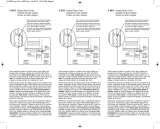The Comnet FDW1000 Series, comprising the FDW1000 and EXP101 devices, offers long-range fiber optic connections between door/gate readers and access control panels, supporting various data formats including Wiegand, strobed, and F/2F. With expansion modules, up to seven readers can share the optical link, simplifying installation and extending the reach of your access control system.
The Comnet FDW1000 Series, comprising the FDW1000 and EXP101 devices, offers long-range fiber optic connections between door/gate readers and access control panels, supporting various data formats including Wiegand, strobed, and F/2F. With expansion modules, up to seven readers can share the optical link, simplifying installation and extending the reach of your access control system.




















-
 1
1
-
 2
2
-
 3
3
-
 4
4
-
 5
5
-
 6
6
-
 7
7
-
 8
8
-
 9
9
-
 10
10
-
 11
11
-
 12
12
-
 13
13
-
 14
14
-
 15
15
-
 16
16
-
 17
17
-
 18
18
-
 19
19
-
 20
20
-
 21
21
-
 22
22
-
 23
23
-
 24
24
-
 25
25
-
 26
26
-
 27
27
Comnet FDW1000 Series User manual
- Type
- User manual
- This manual is also suitable for
The Comnet FDW1000 Series, comprising the FDW1000 and EXP101 devices, offers long-range fiber optic connections between door/gate readers and access control panels, supporting various data formats including Wiegand, strobed, and F/2F. With expansion modules, up to seven readers can share the optical link, simplifying installation and extending the reach of your access control system.
Ask a question and I''ll find the answer in the document
Finding information in a document is now easier with AI
Related papers
-
Comnet EXP100 Series Quick start guide
-
Comnet FDC80 Series User manual
-
Comnet RLMC100X Series User manual
-
Comnet RLFDX RS-485 Series User manual
-
Comnet CNGEMC4+2[POE][HO]/M Series User manual
-
Comnet CNGE20MS User manual
-
Comnet RLMCSFPPOEHO User manual
-
Comnet CNGE24MSS2-OB User manual
-
Comnet CNGE1IPS Series User manual
-
Comnet CNXE2GE2TX8MSPOE User manual
Other documents
-
 Prime-Line U 9873 Installation guide
Prime-Line U 9873 Installation guide
-
DirekTronik 20101270 Owner's manual
-
Mackie MR5 User manual
-
Mackie MR5 User manual
-
Microscan Dome Illuminators Configuration Guide
-
DirekTronik 20100151 Owner's manual
-
Microscan Bar Illuminators Configuration Guide
-
Microscan Edge-to-Edge Backlights Configuration Guide
-
Microscan Area Array Illuminators Configuration Guide
-
Microscan CDI Illuminators Configuration Guide



























